|
Techtextil -
Focus on lightweight textiles |
International
Trade Fair for Technical Textiles and Nonwovens in Frankfurt
am Main, 11 to 13 June 2013
|
|
Textile construction with fibre reinforcement
also a focus of the Techtextil symposium |
|
Release:
Messe Frankfurt, March. 18, 2013 |
|
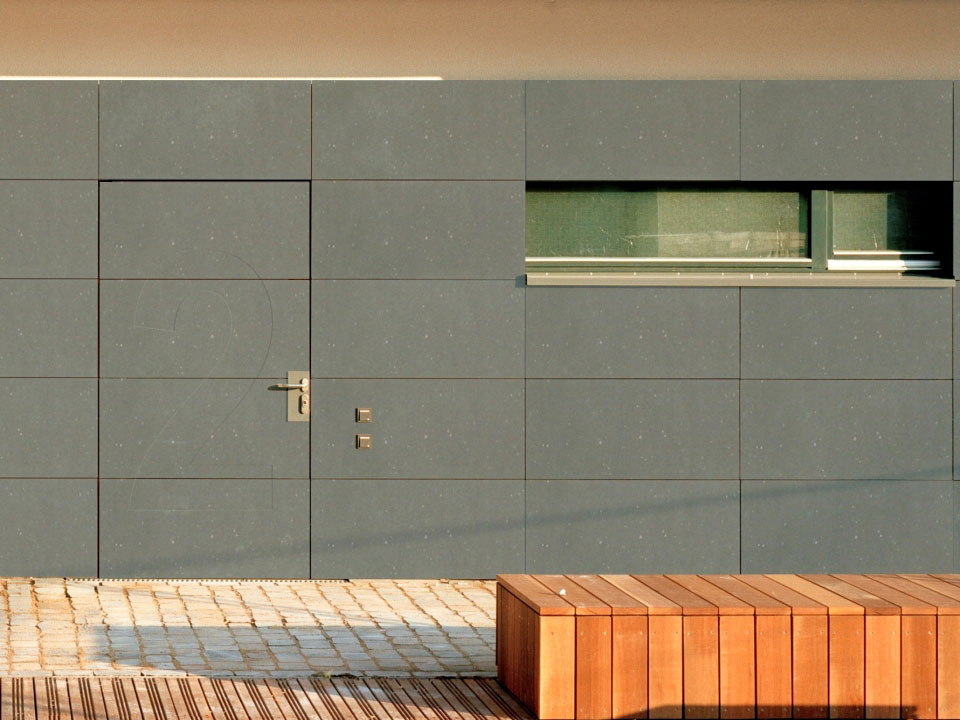 Industry
has long used carbon, glass and aramide fibres for reinforcement.
When combined with concrete, fibre-reinforced structures offer
the building industry ever greater possibilities to reduce the
amount of material used and to create lightweight structures for
building facades and shell structures. Techtextil, the
international trade fair for technical textiles and nonwovens,
takes place from 11 to 13 June 2013 in Frankfurt am Main and is
where leading companies and institutes showcase their latest
developments for lightweight textile design. Industry
has long used carbon, glass and aramide fibres for reinforcement.
When combined with concrete, fibre-reinforced structures offer
the building industry ever greater possibilities to reduce the
amount of material used and to create lightweight structures for
building facades and shell structures. Techtextil, the
international trade fair for technical textiles and nonwovens,
takes place from 11 to 13 June 2013 in Frankfurt am Main and is
where leading companies and institutes showcase their latest
developments for lightweight textile design.
Industry has been using fibre reinforcement for quite some time
especially in motor vehicle construction or in the sports sector.
The added possibility of using carbon fibres in particular for
the manufacture of extremely filigree concrete structures in the
construction industry is relatively new and now a factor in
inspiring both architects and manufacturers to new designs. For
this reason SGL Carbon Group, global market leader in the
production of graphite, that has its head office in Wiesbaden,
has organised an open innovation competition. It ran under the
name of ‘carbocrete’ on the ‘Innovationskraftwerk’ platform of
the ‘Germany – Land of Ideas’ initiative in the spring of 2012
with the aim of searching for new application ideas and usage
scenarios for carbon-fibre reinforced concrete.
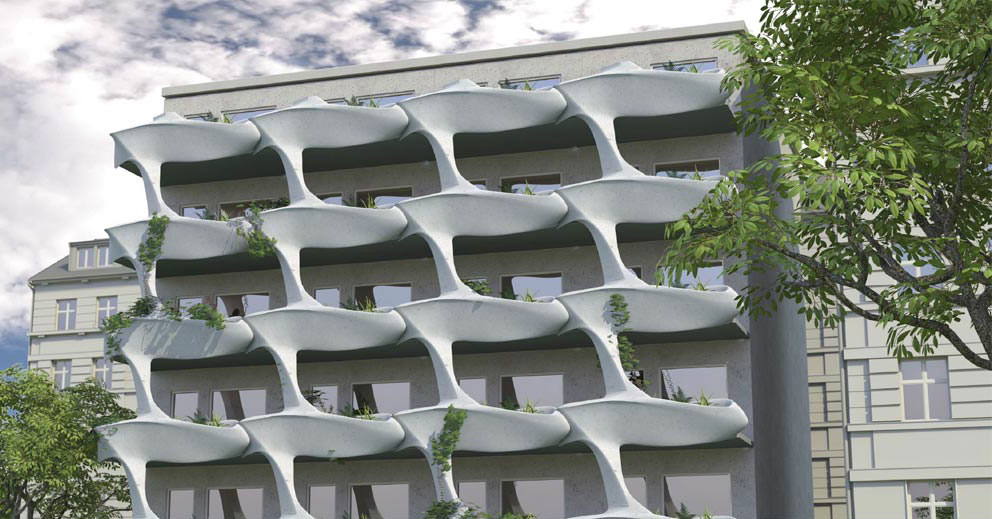 This
composite material is about as new as it gets and offers some
exciting benefits. It is as strong as steel reinforced concrete,
yet up to 75 percent lighter and longer lasting. In contrast to
components made from steel reinforced concrete, those made from
carbocrete cannot rust, which makes them particularly suitable
for contact with water. Over 300 ideas were submitted,
demonstrating the use of the material in terms of outdoor spaces,
weathering and lightweight design. First prize in the
competition went to the team of designers from Leipzig,
Stefan Paulisch, Uta Kleffling and Pamela Voigt with their ‘carbocrete
balconies’, plantable and sensually curved balconies to
counteract the concrete desert character of our town centres.
The special design award went to Vinzenz Maria Hoppe with
a seal-shaped wave-breaker design to reduce coastal
erosion. Its filigree geometry enables it to be mass produced.
“We are impressed by the variety, creativity and quality of the
designs submitted for our first Open Innovation Competition”,
said Dr. Gerd Wingefeld, member of the SGL Group
management board. “This shows us the real potential of
carbocrete as a lightweight construction material and we are
only at the start in terms of development.” This
composite material is about as new as it gets and offers some
exciting benefits. It is as strong as steel reinforced concrete,
yet up to 75 percent lighter and longer lasting. In contrast to
components made from steel reinforced concrete, those made from
carbocrete cannot rust, which makes them particularly suitable
for contact with water. Over 300 ideas were submitted,
demonstrating the use of the material in terms of outdoor spaces,
weathering and lightweight design. First prize in the
competition went to the team of designers from Leipzig,
Stefan Paulisch, Uta Kleffling and Pamela Voigt with their ‘carbocrete
balconies’, plantable and sensually curved balconies to
counteract the concrete desert character of our town centres.
The special design award went to Vinzenz Maria Hoppe with
a seal-shaped wave-breaker design to reduce coastal
erosion. Its filigree geometry enables it to be mass produced.
“We are impressed by the variety, creativity and quality of the
designs submitted for our first Open Innovation Competition”,
said Dr. Gerd Wingefeld, member of the SGL Group
management board. “This shows us the real potential of
carbocrete as a lightweight construction material and we are
only at the start in terms of development.”
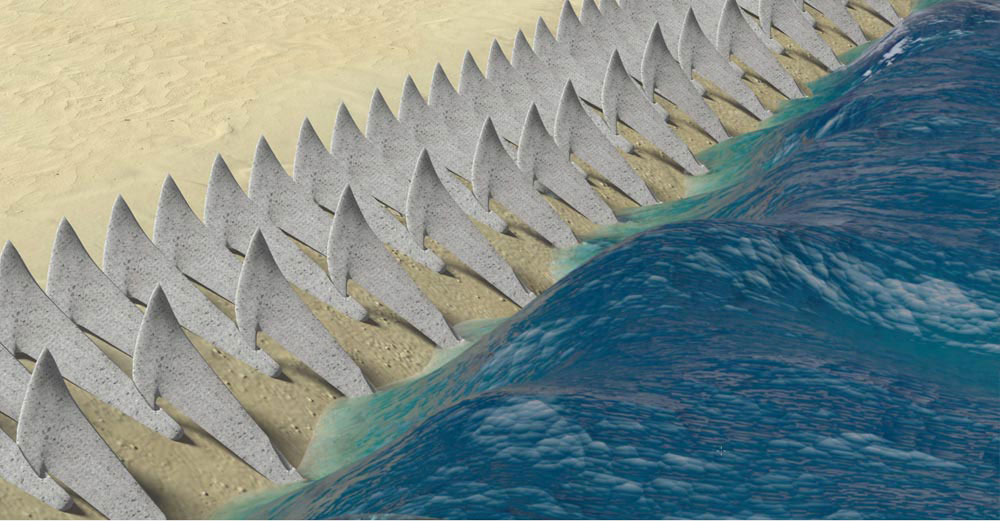 In
current research projects at the RWTH Aachen University, the
Technical University of Dresden or the Saxon Textile Research
Institute (STFI) in Chemnitz work is being done to underpin the
possibilities of organic design using 3D textile reinforcement
with the necessary know-how and new material developments. So as
part of a collaborative project with the Technical University of
Chemnitz, the FiberTech Group, Hentschke Bau GmbH in addition to
Panadur GmbH and Metallbau Hausmann GmbH the STFI has developed
a new hybrid material that has combines the advantages of
textile reinforced concrete with those of glass fibre reinforced
plastic in terms of strength, durability and design flexibility.
3D woven fabrics made from glass filament yarns in a mesh
configuration are used for the reinforcement. To visualise the
results a reference building was created that took the form of a
pavilion made from pre-fabricated textile concrete components
reinforced with glass fibre. The textile reinforced concrete
used a layer of biaxial warp knitted fabric as reinforcement
made from alkali resistant glass fibres (2400 tex). It was
constructed from four layers of glass fabric to create building
components with a thickness of 10 mm and a tensile strength of
up to 165 MPa. To prevent the two materials tearing or
decoupling in terms of their mechanical, chemical and thermal
properties an intermediate layer was used consisting of epoxy
resin and polyester honeycomb unwoven. In
current research projects at the RWTH Aachen University, the
Technical University of Dresden or the Saxon Textile Research
Institute (STFI) in Chemnitz work is being done to underpin the
possibilities of organic design using 3D textile reinforcement
with the necessary know-how and new material developments. So as
part of a collaborative project with the Technical University of
Chemnitz, the FiberTech Group, Hentschke Bau GmbH in addition to
Panadur GmbH and Metallbau Hausmann GmbH the STFI has developed
a new hybrid material that has combines the advantages of
textile reinforced concrete with those of glass fibre reinforced
plastic in terms of strength, durability and design flexibility.
3D woven fabrics made from glass filament yarns in a mesh
configuration are used for the reinforcement. To visualise the
results a reference building was created that took the form of a
pavilion made from pre-fabricated textile concrete components
reinforced with glass fibre. The textile reinforced concrete
used a layer of biaxial warp knitted fabric as reinforcement
made from alkali resistant glass fibres (2400 tex). It was
constructed from four layers of glass fabric to create building
components with a thickness of 10 mm and a tensile strength of
up to 165 MPa. To prevent the two materials tearing or
decoupling in terms of their mechanical, chemical and thermal
properties an intermediate layer was used consisting of epoxy
resin and polyester honeycomb unwoven.
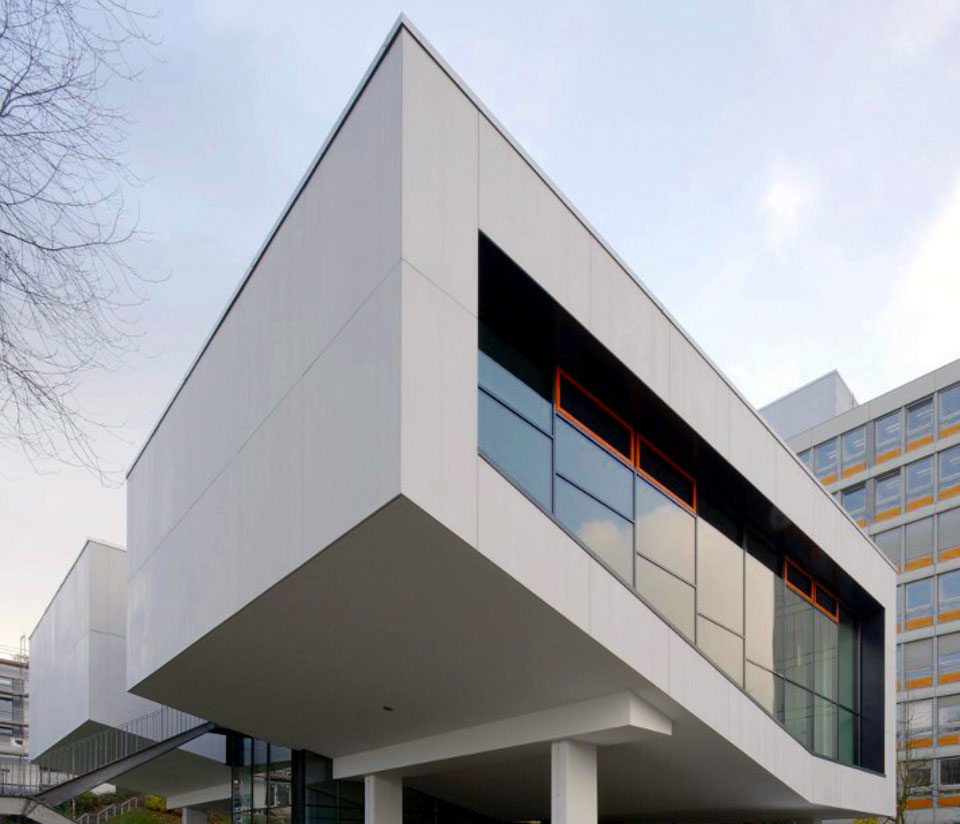 HERING,
manufacturer of building materials has implemented a similar
development in cooperation with the RWTH Aachen University,
creating a betoShell fascia system from fascia panels that are
only 30 mm thick and equipped with a 3D textile reinforcement
that is able to withstand wind pressures of up to 1.80 kN/m².
The SITgrid spacer textile from V. Fraas Solutions was used for
its extremely high load bearing capacity and particularly low
intrinsic weight. This was tailored especially to the
requirements of fascia elements and consists of two glass fibre
layers 10 mm apart which are joined together through rigid
compression by pile threads. A production line allows the
concrete fascia panels to be manufactured in large dimensions up
to 6,000 x 3,000 mm. Its low weight has advantages for transport
and installation. In contrast to comparable steel reinforced
fascia components betoShell saves up to 80% in terms of the
resources needed to manufacture the panels. Concrete fascias can
be decorated with differently coloured aggregates in addition to
being sandblasted, polished or acidified. Life Cycle Engineering
Experts (LCEE) Institute from Darmstadt was able to verify its
superior life-cycle assessment compared to other fascia systems. HERING,
manufacturer of building materials has implemented a similar
development in cooperation with the RWTH Aachen University,
creating a betoShell fascia system from fascia panels that are
only 30 mm thick and equipped with a 3D textile reinforcement
that is able to withstand wind pressures of up to 1.80 kN/m².
The SITgrid spacer textile from V. Fraas Solutions was used for
its extremely high load bearing capacity and particularly low
intrinsic weight. This was tailored especially to the
requirements of fascia elements and consists of two glass fibre
layers 10 mm apart which are joined together through rigid
compression by pile threads. A production line allows the
concrete fascia panels to be manufactured in large dimensions up
to 6,000 x 3,000 mm. Its low weight has advantages for transport
and installation. In contrast to comparable steel reinforced
fascia components betoShell saves up to 80% in terms of the
resources needed to manufacture the panels. Concrete fascias can
be decorated with differently coloured aggregates in addition to
being sandblasted, polished or acidified. Life Cycle Engineering
Experts (LCEE) Institute from Darmstadt was able to verify its
superior life-cycle assessment compared to other fascia systems.
Lightweight structures using membrane textiles have their
advantages especially for the construction of large shell
structures for football stadia or airports. Over the last few
years Verseidag Indutex GmbH from Krefeld has become one of the
market leaders in this area with the erection of a number of
spectacular buildings. The company manufactures high quality
fabrics made from glass or polyester fibres and coats these with
PTFE and / or PVC for protection against the effects of
weathering. In addition the fabrics are equipped with a low E
coating that prevents the heat from permeating to the interior
and reflects sunlight. This creates a pleasant interior climate
whilst at the same time reducing energy costs for
air-conditioning.
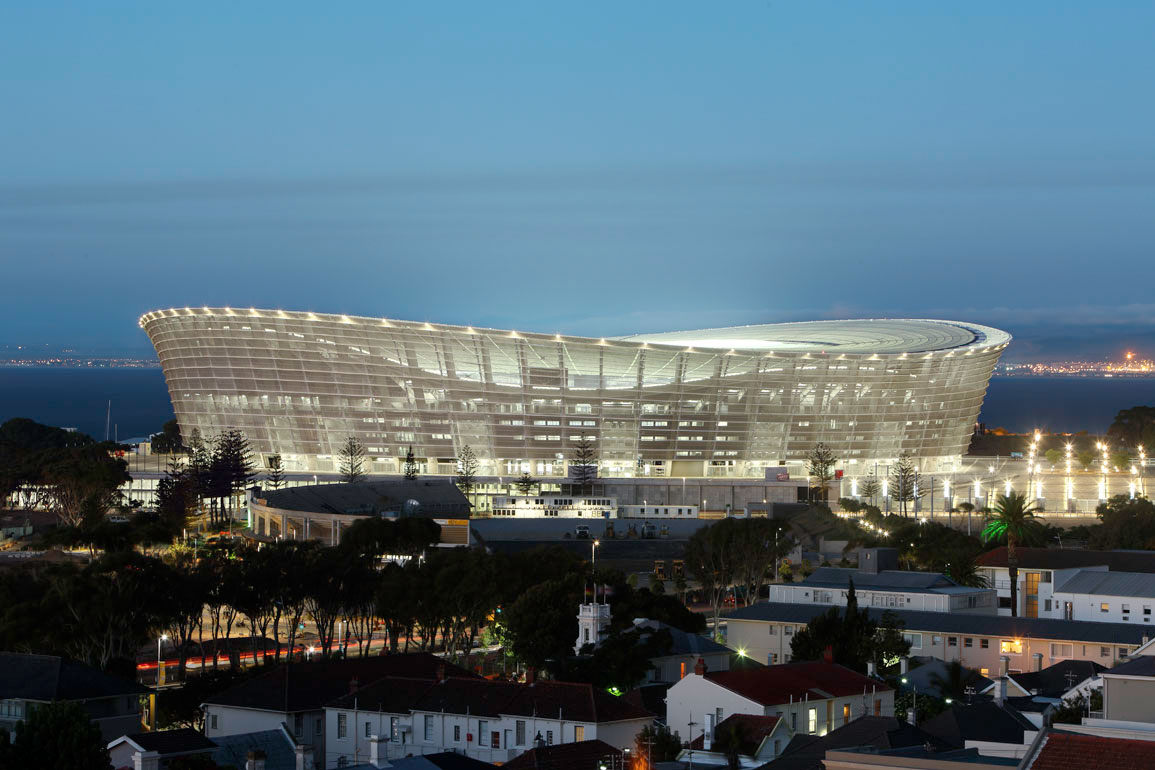 The
construction of the Green Point football stadium in Capetown
also utilised the optical possibilities of textile structures.
The natural white glass fibre fabric was given a special coating,
which during the day has the effect that sunlight is reflected
from the textile skin, making it seem opaque, while at night the
effect is reversed due to the fabrics permeability to light from
the inside and the facade takes on a floating transparency. “In
addition, while the fabric does indeed cut out rain and wind, it
is at the same time permeable to air and prevents heat
accumulating in the summer,” explains Dr. Peter Siemens, head of
the development and innovation department at Verseidag Indutex
GmbH. Recently a digitally printable version has be made
available and is suitable for shell structures in roofs and
facades. The
construction of the Green Point football stadium in Capetown
also utilised the optical possibilities of textile structures.
The natural white glass fibre fabric was given a special coating,
which during the day has the effect that sunlight is reflected
from the textile skin, making it seem opaque, while at night the
effect is reversed due to the fabrics permeability to light from
the inside and the facade takes on a floating transparency. “In
addition, while the fabric does indeed cut out rain and wind, it
is at the same time permeable to air and prevents heat
accumulating in the summer,” explains Dr. Peter Siemens, head of
the development and innovation department at Verseidag Indutex
GmbH. Recently a digitally printable version has be made
available and is suitable for shell structures in roofs and
facades.
Techtextil, international trade fair for technical textiles and
nonwovens Techtextil 2013 (11 – 13 June 2013) is a leading world
trade fair and, regarded as an industry highlight, it brings
together under one roof all product groups and application
fields for technical textiles. It is where industry, research,
designers and the trade find the entire spectrum of issues
surrounding technical textiles and non-wovens in all their
disciplines on the only innovation platform of its kind in the
world. The trade fair takes place on a biannual basis in
Frankfurt am Main and on this occasion it also has a special
focus on the potential of textiles for the building sector. On
Thursday 13 June as part of the Techtextil Symposium, which is
being held in the Messe Frankfurt Congress Center parallel to
the trade fair, recognised speakers will present new insights in
the field of textile reinforced concrete in the block of
lectures entitled ‘textile reinforced concrete’. Additional
information about Techtextil 2013: www.techtextil.com
About Texprocess Techtextil is held concurrently with Texprocess,
Leading International Trade Fair for Processing Textile and
Flexible Materials, and runs from 10 to 13 June 2013. At
Texprocess, manufacturers from all over the world present their
high-tech solutions for the apparel industry and textile
processing. The spectrum of products ranges from design, pattern
development and cutting, via sewing and joining, to embroidery,
textile finishing, IT and logistics. The première of Texprocess
in 2011 attracted 326 exhibitors and 17,000 trade visitors,
6,500 of them from Techtextil. Further information can be found
on the internet at www.texprocess.com Background information on
Messe Frankfurt Messe Frankfurt is Germany’s leading trade fair
organiser, with 538* million euros in sales and 1,891* active
employees worldwide. The Messe Frankfurt Group has a global
network of 28 subsidiaries and approx. 50 international Sales
Partners, giving it a presence for its customers in more than
150 countries. Events “made by Messe Frankfurt” take place at
more than 30 locations around the globe. In 2012, Messe
Frankfurt organised 109* trade fairs, of which more than half
took place outside Germany. Messe Frankfurt’s exhibition grounds,
featuring 578,000 square metres, are currently home to ten
exhibition halls and an adjacent Congress Center. The company is
publicly owned, with the City of Frankfurt holding 60 percent
and the State of Hesse 40 percent. For more information, please
visit our website at: www.messefrankfurt.com * Preliminary
figures (2012).
|
|
Kulturexpress ISSN
1862-1996 |
March 18, 2013 |
|
 Industry
has long used carbon, glass and aramide fibres for reinforcement.
When combined with concrete, fibre-reinforced structures offer
the building industry ever greater possibilities to reduce the
amount of material used and to create lightweight structures for
building facades and shell structures. Techtextil, the
international trade fair for technical textiles and nonwovens,
takes place from 11 to 13 June 2013 in Frankfurt am Main and is
where leading companies and institutes showcase their latest
developments for lightweight textile design.
Industry
has long used carbon, glass and aramide fibres for reinforcement.
When combined with concrete, fibre-reinforced structures offer
the building industry ever greater possibilities to reduce the
amount of material used and to create lightweight structures for
building facades and shell structures. Techtextil, the
international trade fair for technical textiles and nonwovens,
takes place from 11 to 13 June 2013 in Frankfurt am Main and is
where leading companies and institutes showcase their latest
developments for lightweight textile design. 


